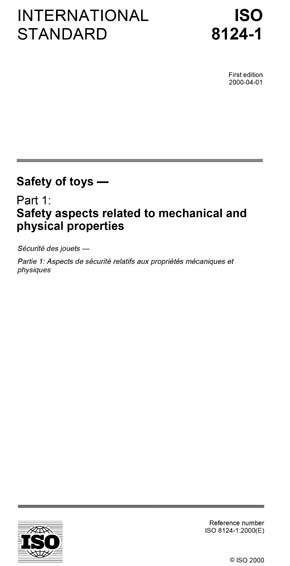Historical
ISO 8124-1:2000
Safety of toys - Part 1: Safety aspects related to mechanical and physical properties
The requirements in this part of ISO 8124 apply to all toys, i.e. any product or material designed or clearly intended for use in play by children under 14 years of age. They are applicable to a toy as it is initially received by the consumer and, in addition, they apply after a toy is subjected to reasonably foreseeable conditions of normal use and abuse unless specifically noted otherwise.
The requirements of this part of ISO 8124 specify acceptable criteria for structural characteristics of toys, such as shape, size, contour, spacing (e.g. rattles, small parts, sharp points and edges, hinge-line clearances) as well as acceptable criteria for properties peculiar to certain categories of toy (e.g. maximum kinetic energy values for non-resilient-tipped projectiles, minimum tip angles for certain ride-on toys).
This part of ISO 8124 specifies requirements and test methods for toys intended for use by children in various age groups from birth to 14 years. The requirements vary according to the age group for which a particular toy is intended. The requirements for a particular age group reflect the nature of the hazards and the expected mental and/or physical abilities of the child to cope with them.
This part of ISO 8124 also requires that appropriate warnings and/or instructions for use be given on certain toys or their packaging. Due to linguistic problems that may occur in different countries, the wording of these warnings and instructions is not specified but given as general information in annex C. It should be noted that different legal requirements exist in many countries with regard to such marking.
This part of ISO 8124 does not purport to cover or include every conceivable potential hazard of a particular toy or toy category. Except for labelling requirements indicating the functional hazards and the age range for which the toy is intended, this part of ISO 8124 has no requirements for those characteristics of toys that represent an inherent and recognized hazard that is integral to the function of the toy.
Products not included within the scope of this part of ISO 8124 are
- bicycles, except for those considered to be toys, i.e. those having a maximum saddle height of 435 mm (see E.1);
- slingshots;
- darts with metal points;
- home and public playground equipment;
- compressed air and gas operated guns and pistols (see E.1);
- kites (except for the electric resistance of their strings, which is included);
- model kits, hobby and craft items in which the finished item is not primarily of play value;
- sporting goods and equipment, camping goods, athletic equipment, musical instruments and furniture; however, toys that are their counterparts are included.
It is recognized that there is often a fine distinction between, for example, a musical instrument or a sporting item and its toy counterpart. The intention of the manufacturer or distributor, as well as normal use and reasonably foreseeable abuse, determines whether the item is a toy counterpart or not;
- models of aircraft, rockets, boats and land vehicles powered by combustion engines; however, toys that are their counterparts are included (see E.1);
- collectible products not intended for children under 14 years of age;
- holiday decorations that are primarily intended for ornamental purposes;
- aquatic equipment intended to be used in deep water;
- toys installed in public places (e.g. arcades and shopping centres);
- puzzles having more than 500 pieces or without a picture, for specialists;
- fireworks including percussion caps, except percussion caps specifically designed for toys;
- products containing heating elements intended for use under the supervision of an adult in a teaching context;
- steam engines;
- video toys that can be connected to a video screen and operated at a nominal voltage greater than 24 V;
- babies' pacifiers (dummies);
- faithful reproduction of firearms;
- electric ovens, irons or other functional products operated at a nominal voltage greater than 24 V;
- bows for archery with an overall relaxed length exceeding 120 cm;
- fashion jewellery for children (see E.1).
Content Provider
International Organization for Standardization [iso]






